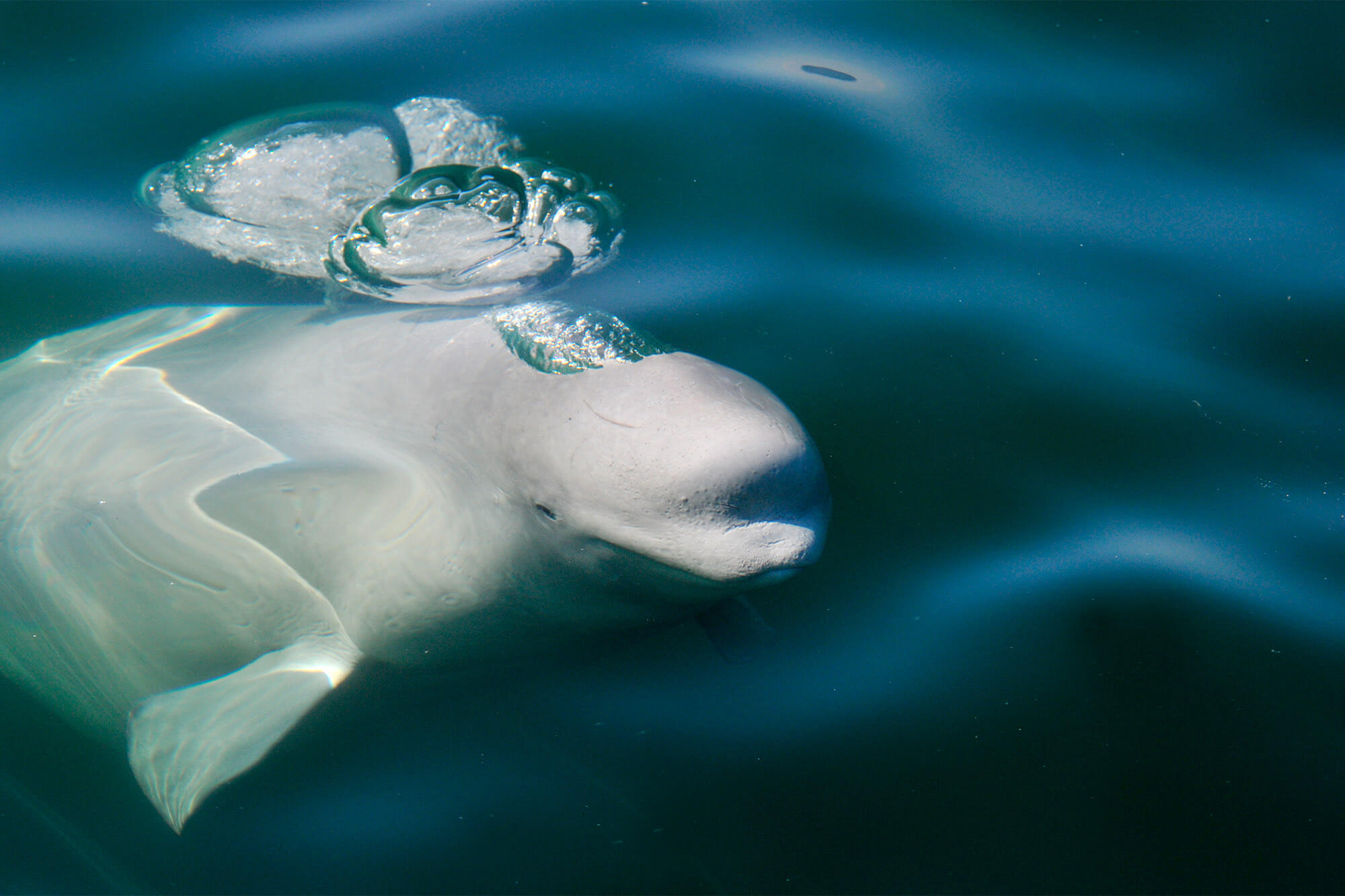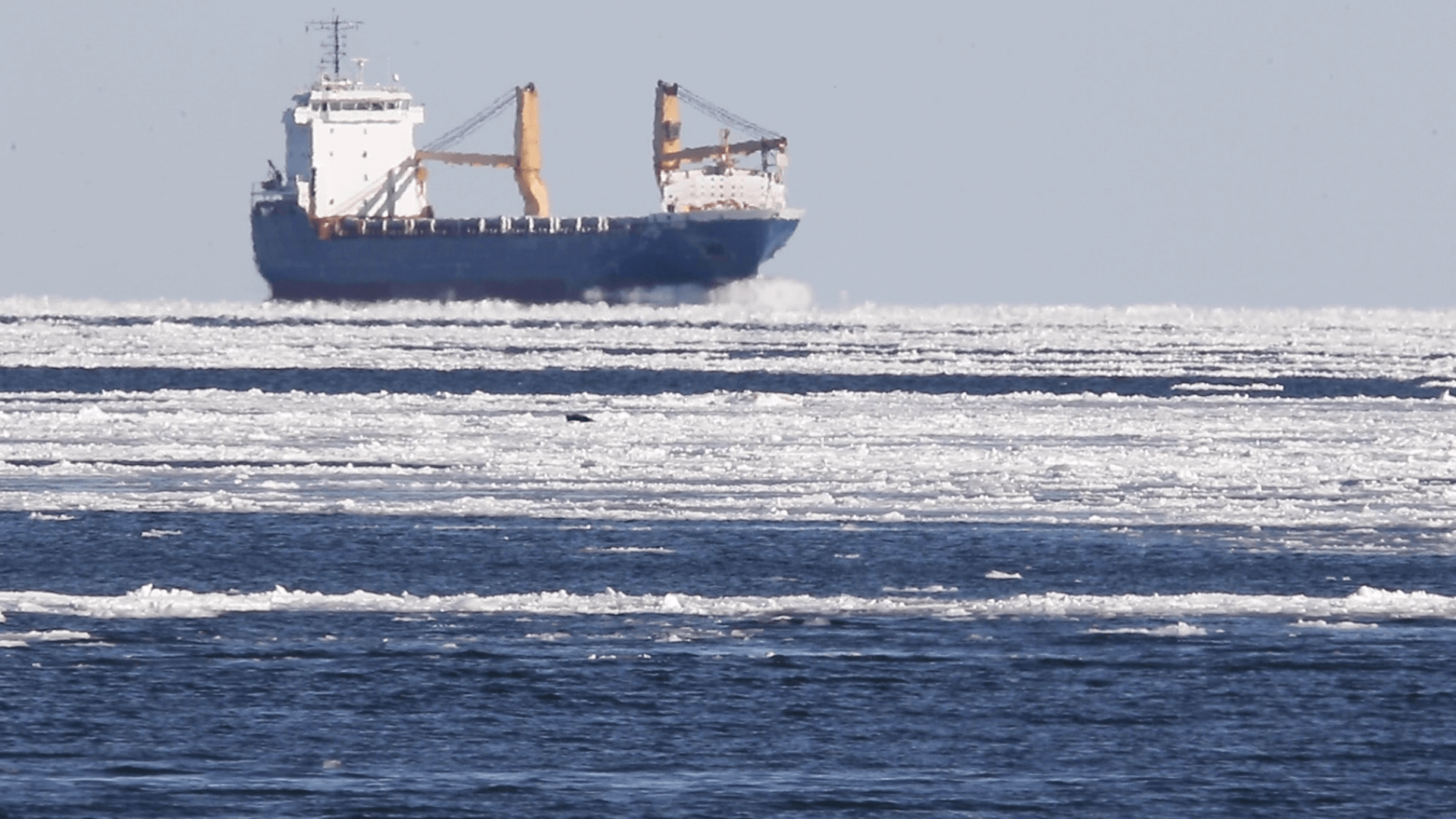In 1988, the International Forum for the Future of the Beluga was held. Just five years earlier, in 1983, the St. Lawrence beluga had been added to Canada’s endangered species list. Thirty-five years after this event that left its mark on the community, how far has science come?
It was in an effort to address this question that the 2023 Beluga Symposium was organized. More than thirty presentations were given under three different themes: ecology and population, animal health and contaminants, and maritime traffic and acoustics. Topical workshops and poster presentations were also organized. At the end of the symposium, a plenary session presented some of the conclusions made by the scientists. Still on the list of species at risk and currently considered endangered, belugas are more sensitive than ever to disruptions in their ecosystem and human disturbance.
This page was created to track this event and is updated with each new development to provide you with a summary in as close to real time as possible! Don’t miss a thing… follow us on Instagram, Twitter or Facebook!
40 years of science… for the future of belugas
Presented by: Pierre Béland, Canadian chair of the International Joint Commission that has jurisdiction over the boundary waters between Canada and the United States, and GREMM president Robert Michaud
The first presentation of the symposium set the tone for the rest of the event. Pierre Béland explained how he was inspired by belugas during his first encounters with these animals. “When they’re close enough and you see them, they just pull you in. I was struck by their beauty, and at the same time by how fragile they looked.” Going back to the early 1980s, he shared his early experiences and research devoted to discovering how these white whales could be contaminated with flame retardants from a factory on one of the Great Lakes.
In the next part of the presentation, Robert Michaud presented beluga research and how it has evolved over the past 40 years. While in the past, scientific articles seemed to be rather focused on a single theme, the last decade has seen more studies that bridge different lines of research. In 2012, an significant uptick in newborn mortalities led to an increase in research on this species. To answer the question “Where are we headed?” Robert replies that he lets the symposium answer this question.
In a bid to encourage young students to engage in research, Pierre Béland concludes that knowledge has no limits.
Ecology and population
One of the objectives of several scientists attending the 2023 Beluga Symposium was to better understand St. Lawrence beluga ecology and the habitat frequented by the species. Under the “ecology and population” theme, several researchers took the floor to present the results of their work. Habitat use, diet, birth rate and the use of artificial intelligence are just a few examples of the research topics presented in this session.
Some of these research projects are still in progress and will provide a critical look at the beluga’s distribution, especially in those areas used by female communities. The summer and winter ranges of these white whales is rather well known: the species is believed to frequent the northeastern reaches of the gulf in winter, and the head of the Laurentian Channel mainly during the summer. In terms of food, belugas appear to be more generalists than before, with a considerable diversity of prey having been identified in their diet.
Artificial intelligence has clearly made its way into the field of whale research. It is now being used to study and assess the number of belugas in a given sector, which represents an important step forward. Great strides have also been made in the field of photo-identification, making it increasingly straightforward to identify an individual that has already been observed in the past, which saves scientists considerable time.
Animal health and contaminants
With discussions of cancer, contaminants and dystocia, the second main theme of the symposium drew reactions from within the scientific and student community.
The 40th year of the beluga carcass recovery program raises concerns about the number of recorded cases of dystocia as well as postpartum and neonatal mortality. Changes in the beluga’s environment might be to blame, whether it be disturbance caused by ships or the presence of contaminants with the potential to disrupt the animals’ hormones
Indeed, a number of contaminants can be found in the beluga’s habitat, including flame retardants, PCBs, and ultraviolet absorbers found in everyday products such as sunscreen and paint. These chemicals have been measured in high quantities in the fat of belugas and some of their prey. Ongoing studies may help researchers make certain recommendations on these contaminants or guide management plans for species and environments that are suffering impacts.
At the same time, scientists are working on assessing the animals’ physical fitness levels by using photogrammetry and analyzing morphometric data, thereby gaining insight into the links between the body condition of individual belugas and the health status of the population at large.
Stéphane Lair, professor at Université de Montréal’s Faculty of Veterinary Medicine, had some positive news to share. “Cancer is no longer a conservation issue for the species,” he explains. Indeed, PAH (a contaminant responsible for cancer in belugas) concentrations have been trending downward since 1977. However, this statement should be interpreted with caution, as there are still a number of issues affecting the health of the St. Lawrence beluga, including parasites such as Toxoplasma, whose hosts include domestic cats.
Science working for St. Lawrence beluga conservation
Presented by: Nadia Ménard, ecosystem scientist for Parks Canada
The second day of this scientific gathering kicked off with a presentation by Nadia Ménard. Nadia’s interest in belugas came late, as this Saguenay native grew up completely unaware that these famous white whales lived just a few kilometres from her home! She first studied the biology of pelagic fish before becoming a conservation biologist.
Nadia begins by recalling the importance of research: “If we don’t know what the problem is, how can we solve it?” Nadia also recognizes the importance of integrating human aspects and focusing on solutions. After a brief recap of the last 50 years in conservation science, she sums up the various changes taking place in the St. Lawrence and their impacts, in particular rising winter air temperatures, increased inflow from the Gulf Stream, decreased inflow from the Labrador Current, and the presence of contaminants. To counterbalance discussions on the threats faced by the St. Lawrence, she recalls some of the positive results that science has helped achieve such as the creation of the Saguenay-St. Lawrence Marine Park or the designation of critical beluga habitat. The scientist ended with an inspiring quote from Charles Darwin: “In the long history of humankind, those who learned to collaborate and improvise most effectively have prevailed.”
Maritime traffic and acoustics
For the final theme of the symposium, the speakers made no qualms about using mathematics, statistics or even artificial intelligence. To understand the different threats that are affecting the St. Lawrence beluga, let’s not forget our equations and algorithms!
The research presented ranged from simulating beluga and watercraft movements to creating the Ocean Soundscape Atlas and quantifying boat noise using hydrophones. However, all of them had the objective of improving the conditions in which these white whales live. Nicknamed “canaries of the seas,” belugas have a rich vocal repertoire and a complex social structure that can be disrupted by boat noise.
At the mouth of the Saguenay Fjord, disturbance related to shipping and boating activities is particularly acute. Ferries, recreational boats, whale-watching cruises, and other types of watercraft travelling up the Saguenay make this a noisy corridor in the heart of the beluga’s critical habitat. Some projects therefore aim to improve our cohabitation with this endangered species by working to enforce speed limits. Solutions that were presented and assessed included the reduction of watercraft speeds and mitigation of ship noise at the source.
Challenges and successes of a small population exposed to multiple anthropogenic stressors and climate change
Presented by: Véronique Lesage, researcher with Fisheries and Oceans Canada
The closing presentation of the symposium was an emotional one. “There are more belugas in the St. Lawrence than previously believed,” Véronique Lesage announced during her presentation. Using a new model, the most recent estimate (2022) indicates that there might be between 1,530 and 2,180 belugas in the St. Lawrence. However, this range of figures should not be taken at face value. In other words, it does not mean that the population is increasing; rather, it is the quantification method that has changed.
The population still faces a number of major challenges that worry scientists. It would appear that females are dying younger than before, which has a direct impact on birth rates. That translates into 2 or 3 calves that each female will never produce. A decline is also being observed in the survival of newborns. “Mortality in calves and females is devastating the population’s chances to grow,” adds Véronique.
It should be recalled that although the number of belugas has been revised upwards, the population is not increasing. There is still a lot of knowledge to acquire before we fully understand what influences this species and how we can help it recover.








